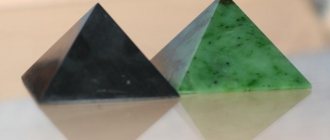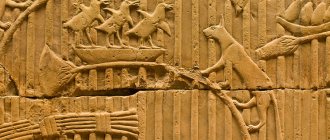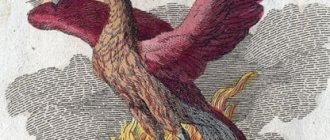| heron Greek . —Herodios lat . —Ardea A large, long-legged wading bird with a sharp and long beak. Has a symbolic meaning based on, g.o. on features of appearance and behavior. The solar bird, the personification of waters and dawn: standing in the water/on the shore, it is the first to meet and greet the morning star. Shares symbolism:
Unlike the latter, the long beak of a heron is considered not a phallic symbol, but a sign of curiosity (cf.: “poking your nose everywhere”) and interest. Basic values:
|
Content
- 1 Basic values:
- 2 Egypt
- 3 Antiquity
- 4 Northern tradition
- 5 Southeast Asia
- 6 China
- 7 Buddhism
- 8 Taoism
- 9 Christianity
- 10 Fortune telling
- 11 Heraldry
- 12 Emblems
- 13 Art
- 14 Ad vocem
- 15 Literature
- 16 Notes and comments
See also:
Birds Solar bird Poseidon Frigga Benu Stork Crane
The meaning of the word Heron according to the Symbolism Dictionary:
The heron is a solar bird that has much in common with the crane and stork. In addition, it symbolizes vigilance and calm. This is a bird of the waters. In Buddhism and Taoism it takes on the symbolism of the crane (cm-). In Chinese and Japanese symbolism , the egret, associated with the black crow, forms the opposition of yin-yang, solar and lunar, light and darkness, a serious and silent creature (a thinker), and another, malicious and talkative. The heron represents tact and delicacy, as it takes off without muddying the waters. In art it is associated with willow. Among the Egyptians, the heron is the first creature that transforms the soul after death. It is believed that Bennu is a type of heron, and perhaps it is a phoenix, because it also symbolizes the rising Sun, rebirth, the return of Osiris, and, like the bird of the Nile flood, the renewal of life. When the Nile floods, the heron leaves the river and flies over the fields.
Antiquity
The legendary enemy of the eagle and the lark, but the friend of the crow.
Sacred bird of Poseidon.
Mediterranean sailors considered the heron to be the bird of Aphrodite and the patroness of sailors.
Her appearance was perceived as a favorable sign (augurium). The white heron promised special luck.
“A heron appeared, flying from the right side, and although it was not possible to see it properly, since it was night, the cry of the heron delighted Odysseus.” Homer "Iliad"
By the way the heron hides, the weather, mainly rains and storms, was predicted with great accuracy.
Like the bittern, a symbol of constant idleness and laziness: in Ancient Greece it was believed that these birds, hiding in the reed thickets all day, were turned into slaves of herons.
When Aeneas destroyed the capital of the Rutulians - the city of Ardeen, birds were found among the ashes, which in Latin were called: “Ardeae”, that is, “a genus of herons” (“Metamorphoses” by Ovid).
According to Pliny the Elder, when mating, herons experience the same sensations as when laying eggs, and among other things, they could shed tears from sadness and sadness.
In Aesop's fable, she must risk her head to pull a bone out of a wolf's mouth.
The meaning of the word Heron according to the Brockhaus and Efron dictionary:
Heron (in fish farming). — C. (Ardea cinerea) is one of the most harmful birds for fish. Among the enemies of fish bred in ponds, only the otter can compete with it. With its rapid digestion, C. needs a very large amount of food. In the crop and stomach of Ts., caught immediately after her hunt, there are up to a dozen palm-length fish. Where Ts. is not disturbed, there she visits the waters where she hunts at certain times of the day. If she is disturbed, she changes these hours, but as long as there are fish in the pond, it is very difficult to drive them away from the pond. Due to the special caution of this bird, it is quite difficult to shoot it from guns. The most rational remedy against it is the destruction of its nests, which Ts. arranges either on tree branches or in reed thickets. Before the time of departure of the young C., this technique can be used to destroy the C. with its offspring. Another, even more common way of fighting Ts. is to catch it with saucer traps, which are used to catch otters, rats, etc. Ts. gets caught in a trap or with his foot, wandering through small places where a weapon is placed, or - by the neck. in the latter case, bait is made from fish. In some places, C. is exterminated by poisoning bait fish with phosphoric acid. Almost all German fishing societies (and there are hundreds of them) give special prizes for each head of a killed fish (as well as an otter), and these prizes constitute one of the most prominent items in the annual budget of German fishing societies. N. Borodin.
Christianity
One of the birds that knows “their specific times”[1].
The early Christian Physiologist points out that the heron is the most unpretentious of all birds: “its bed and its table are in the same place” and does not “fly here and there.” Therefore, it serves as a symbol of a Christian who should not visit many places of heretics, but must protect himself from the “brew of heretical and erroneous teachings.”
According to the medieval Bestiary, the heron has an aversion to rain and flies high above the clouds, foreshadowing a thunderstorm. Sometimes found as an allegory of believers rising above the storms of life like a heron overcoming rain clouds.
Symbol:
- Christ on the Mount of Olives - due to the legendary ability to shed tears;
- Christ “slaying” Satan - as a destroyer of snakes
- repentance - by the ashen color of the plumage of a gray heron.
How to activate the heron talisman in feng shui
Heron mascot
The heron is considered a sun bird. To activate the heron talisman, you should place its figurine on the sunny side of your house. Thus, by absorbing the energy of the sun, the heron works better and brings more benefits.
If you have a decorative fountain or aquarium in your home, place it next to the heron as well. Proximity to water has a creative effect on activating the talisman into action.
If you place the heron talisman over the symbolic nest, then the heron will acquire very close contact with your home and will be able to show maximum care to you and your children.
A heron, as a mascot in your home, can do a lot for you. In a variety of world cultures and traditions, this noble bird is considered a symbol of freedom, wind, sun and sky, abundance, protection and inspiration. The heron mascot is ready to do a lot for its admirers.
Emblematics
“This bird is a symbol of the souls of the chosen ones, who, out of fear of the storms of this world, direct all their aspirations beyond the boundaries of mortal existence to the heights of their heavenly homeland. Some of the herons are white, others are ash-gray; white is the color of innocence, ash-gray is the color of repentance...” Unterkircher “The heron, when it senses impending bad weather, Prudently rises above the storm clouds. So the pious heart, when trouble is about to strike, tends to seek refuge only in God’s Kindness.” Hochberg. 1675
A heron carrying a flower in its beak.
- You know them all.
A symbol of the instincts and knowledge that herons are endowed with.
EMSI 51-15 Heron flying above the clouds.
- I am above all hurricanes and storms.
A symbol of aspiration to heaven. “He whose goal is above the clouds becomes inaccessible to hurricanes and storms - unrest and anxiety.” EMSI 23-9
Material of figurines
The material for making the figurine should be natural material, because... It is precisely such materials that are a source of positive energy:
- wood – wooden figurines should be placed in the Family zone;
- metal is responsible for the Travel and Childhood zones;
- stone – travelers are recommended to place products made from this material in the Knowledge zone.
In addition, figures can be made from:
- ceramics - is a symbol of the Earth and strengthens the atmosphere in the house;
- porcelain - is a symbol of the Earth and strengthens the atmosphere in the house;
- crystal - passes negative energy through itself, transforming it into positive.
Types of herons and their characteristics
There are many species of herons in the world (about 60).
- Gray Heron. One of the largest representatives of the heron family, its height can reach a meter, and its average weight is about two kilograms. Most often the bird is found in Eurasia, Africa and Indonesia. The plumage is gray with black stripes, and there is a black crest on the head. The beak is yellow.
- Great White Heron. It is distinguished by its snow-white plumage and large size - the weight of an adult male is about 1 kg and the height is 1 m. It is found in warm latitudes - in Europe, New Zealand, Asia, Africa, Australia, South America. The heron is listed in the Red Book of Russia.
Photo of great egret - Little white heron. The second name is chepura-need. This is a small bird that is common in the Eastern Hemisphere. In Russia, it can be found in the European part of the country near large rivers. The plumage color is white, average weight is no more than 600 grams.
- Big blue. This is a close relative of the gray heron, but it lives in India, Central and South America, and is found on the Galapagos Islands. She was also seen on Ratmanov Island in Russia, but she ended up there, most likely, by mistake. The bird is large, its weight can reach 2.5 kilograms, and its height is 1.4 meters. The feathers are gray and there are brown and black stripes on the neck.
- Shoebill heron. It is also called the royal heron. Belongs to the shoebill family. Lives in East Africa. The peculiarity of the bird is that its eyes are located in the front, and not on the sides, like other birds. The shoebill is also easily recognized by its large beak, which closely resembles a shoe made of wood.
The beak of the shoebill heron resembles a large wooden shoe - Great heron or little bittern. This is the smallest representative of herons, whose height barely reaches 36 centimeters. The bird weighs about 150 grams. It lives in Africa, Russia and other European countries, India, Australia. The little heron is the only species of heron in which the male and female are different in color. The former have black plumage, and the latter have brown plumage.
- Heron heron. The second name is night heron. A small bird found on all continents except Australia and Antarctica. It is predominantly nocturnal and sits motionless on branches during the day.
- Giant or Goliath heron. Distributed mainly in Africa, in areas located south of the Sahara. Occasionally it can be found in Asia. Prefers to lead a sedentary lifestyle. Weighs up to 7 kilograms, height can reach one and a half meters. For such large dimensions, the bird is called a giant.
Goliath Heron - a large and beautiful bird - Medium white. A small bird with white plumage. Found mainly in Africa, South Asia and Australia. It was spotted in Russia in the Far East.
- White-necked. The second name is Pacific heron. Most representatives of the species live in Australia, but these herons are also found on the island of Tasmania, New Zealand and New Guinea. It is a large bird with black or gray feathers on its body. The neck and head are white.
- Black-necked. Lives in South Africa and Madagascar. Externally, it is very similar to the gray heron, only with a darker color. Short in stature, about 70–80 centimeters.
- South American. Most individuals live throughout South America. Some specimens may fly to the Falkland Islands and Trinidad and Tobago. A large bird weighing up to 2.5 kilograms and more than a meter tall. The plumage is gray, the legs are pink. The head and neck are white, with a black crest.
- Madagascar. This is a rare bird found exclusively in Madagascar. It is listed in the IUCN (International Union for Conservation of Nature) Red List as an endangered species. The heron is small in size, up to about 90 centimeters. Feather color is gray.
A rare species of heron - Madagascar - Redhead. It is found mainly in reeds. Found in European countries, southern Asia and Africa. The color is dim, for easy camouflage. The plumage is red and gray. Very long fingers with sharp claws.
- White-winged. A small bird living in South and East Asia. Individual representatives can be found in Mediterranean countries and in the Primorsky Territory. The bird is very beautiful, especially during the mating season - the head and neck are reddish, the back is gray, and the sides and lower part are white. The height of a heron is no more than half a meter.
- White-bellied. The rarest heron, which is found only in the foothills of the Himalayas in Bhutan, India and Myanmar. Previously nested in Bangladesh and Nepal, but no longer occurs there. Several hundred individuals remain. A large bird, second in size only to gigantic herons. The plumage is mostly gray. Many efforts are being made to protect it; it lives in national parks and reserves. In 2011, the white-bellied heron appeared in captivity for the first time. She was released into the wild after being equipped with a sensor to track her movements.
- Egyptian. One of the most numerous representatives of the heron family, inhabiting almost the entire planet, except for cold areas covered with ice. The bird has a dense, massive body, a relatively short neck and beak. The color of the feathers is white; during the mating season they turn bright colors - orange, yellow, golden.
Singing herons
They voice most often during flights, making sharp sounds that are more like a grinding or hoarse croak. On land they are rather silent birds. They prefer to “talk” only with their fellow tribesmen and do not communicate with other birds. When greeting, herons quickly click their beaks. When they are threatened with danger, and they want to warn their fellow tribesmen about it, they bend their necks and emit a guttural cackle. And if the heron, on the contrary, poses a threat itself, it begins to scream, and vibrating notes can be heard in the scream.
We invite you to watch a short video that demonstrates the singing of herons.








